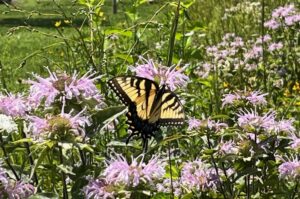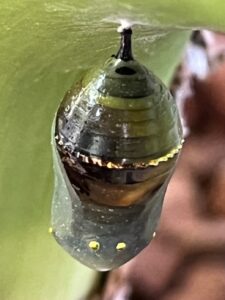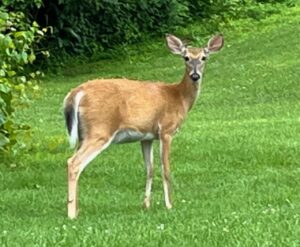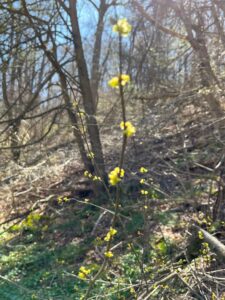The Brandywine Conservancy’s sixth annual ‘Bike the Brandywine’ event to take place on Saturday, September 21, 2024; proceeds from the event will benefit the Brandywine Conservancy’s clean water and open space programs
By Steven Brodsky

Photo courtesy of the Brandywine Conservancy & Museum of Art
From the Brandywine Conservancy & Museum of Art:
Chadds Ford, PA, September 3, 2024 — The sixth edition of the Brandywine Conservancy’s popular “Bike the Brandywine” event is slated to return on Saturday, September 21, 2024. Cyclists can choose between three scenic route options that travel along some of the most picturesque roads in the Brandywine Creek Greenway and the surrounding Chester County countryside. Proceeds from the ride benefit the clean water and open space programs of the Brandywine Conservancy.
This year’s ride offers distances of 25-, 45- and 62-mile (metric century) routes—each with unique and thrilling experiences for both recreational and more seasoned cyclists. Those on the metric century route will journey along the West Branch of the Brandywine Creek, traveling 62 miles through bucolic countryside and historic sites. After departing from Chadds Ford, riders will travel near the Conservancy’s Laurels Preserve, through the magnificent King Ranch area in Unionville and the open agricultural lands just west of the famous Whip Tavern, before winding their way through Modena and the historic village of Marshallton. For a similar ride—with less mileage—the 45-mile route closely follows along to the metric century journey. Those looking for a more recreational option can join the 25-mile ride along the Brandywine Creek Greenway. This loop is a shorter version of the other rides, following the West Branch of the Brandywine through open farmland, scenic river valleys and equestrian landscapes.
Each loop will start and end at the Chadds Ford Historical Society—located at 1736 N Creek Road, Chadds Ford, PA. Well provisioned rest stops will be available every 10-20 miles, depending on the route, with Support and Gear (SAG) assistance provided by Trek Bicycle Delaware throughout the day. The event concludes with a free lunch at the Chadds Ford Historical Society for all participants, along with a complimentary pint or hard Northeast Tea from 2SP Brewing Company for riders over the age of 21. The event will take place rain or shine on September 21, 2024, from 6:30 a.m. to 4:30 p.m. To learn more and register, visit www.BikeTheBrandywine.org.
This year’s Bike the Brandywine is made possible thanks to presenting sponsor, Willowdale Town Center, and supporting sponsors Anemoni Jewelers, Holly Gross Group of Berkshire Hathaway Home Services, Trek Bicycle Delaware, 2SP Brewing Company, and Chadds Ford Historical Society.
About the Brandywine Creek Greenway:
The Brandywine Creek Greenway is a regional planning initiative of the Brandywine Conservancy—involving 29 municipal partners in Pennsylvania (Chester and Delaware counties) and Delaware (New Castle County and the City of Wilmington)—to create a 40-mile-long conservation and recreation corridor along both branches of the Brandywine. The Greenway stretches from the Christina River in the City of Wilmington, Delaware, to the Pennsylvania Highlands in Honey Brook Township. The Brandywine Creek Greenway and its network of parks and trails form the western limit of the Circuit Trails, a regional trail network of the greater Philadelphia region. The vision of the Brandywine Creek Greenway is to build healthier, more sustainable communities, by emphasizing the natural and cultural resources of the area; preserving and protecting the Brandywine River; and creating connections among open space, parks, river access points and area attractions. To learn more, visit www.brandywinegreenway.org
About the Brandywine Conservancy:
The Brandywine Conservancy protects water, conserves land, and engages communities. The Conservancy uses a multi-faceted approach to conservation. Staff work with private landowners who wish to see their lands protected forever and provide innovative community planning services to municipalities and other governmental agencies. The Conservancy currently holds more than 510 conservation and agricultural easements and has facilitated the permanent preservation of over 70,200 acres of land. The Conservancy is a program of the Brandywine Conservancy & Museum of Art.
About the Brandywine Conservancy & Museum of Art:
The Brandywine Conservancy & Museum of Art preserves and promotes the natural and cultural connections between the area’s beautiful landscape, historic sites, and important artists. The Conservancy protects the lands and waters throughout the Brandywine Valley and other priority conservation areas, developing sustainable approaches to emerging needs and assuring preservation of majestic open spaces and protection of natural resources for generations to come. The Museum of Art presents and collects historic and contemporary works of American art, engaging and exciting visitors of all ages through an array of exhibitions and programs. The Brandywine unites the inspiring experiences of art and nature, enhancing the quality of life in its community and among its diverse audiences.
Posted 9-4-24
Happy Labor Day weekend
By Steven Brodsky

Photo by Steven Brodsky
… Enjoy the remaining days of summer!

Photo by Steven Brodsky
Labor Day is but the unofficial end of summer.
The season ain’t over till it’s over.
Posted 8-31-24
Participants in the Pennsylvania Game Commission’s two-month Wild Turkey Sightings Survey should report sightings from July – August 2024 through September 6, 2024
By Steven Brodsky
In a proper season
By Steven Brodsky
… appeared this frog (and the shadow it cast upon a lotus leaf):

Photo by Steven Brodsky
Ecclesiastes 3 KJV (biblehub.com)
This post appeared in the Conversations About Faith section of this column.
Posted 4-25-24, Reposted and Revised 8-14-24
A peaceful and restorative moment in the wilds
By Steven Brodsky

Photo by Steven Brodsky
Posted 8-11-24
Exquisite is the monarch butterfly chrysalis stage
By Steven Brodsky
… as pictured here:

Photo by Steven Brodsky
I can’t say that I find the adult stage of the monarch butterfly to be more exquisite than the monarch chrysalis stage.
Which stage is more exquisite?
Not an easy question (for me) to answer.
It’s easier to simply enjoy seeing these two life stages of the monarch butterfly in the great outdoors!
Posted 8-7-24
Coming into the peace of some wild things
By Steven Brodsky
… with this photo and “The Peace of Wild Things”:

Photo by Steven Brodsky
Posted 7-9-24
The Pennsylvania Game Commission (PGC) updates the public about chronic wasting disease (CWD) surveillance and research
By Steven Brodsky

Photo by Steven Brodsky
This news release was issued today, May 28, 2024, by the Pennsylvania Game Commission (PGC):
HARRISBURG, PA – The 2023-24 deer seasons ended months ago as did the busiest time for chronic wasting disease (CWD) surveillance. CWD, a fatal neurological disease, is a threat to both white-tailed deer and elk and has been detected within the wild deer population in several areas of Pennsylvania. While the most intense efforts revolve around Pennsylvania’s deer hunting seasons, monitoring for CWD is a year-round endeavor. The public can view the results of these efforts on the CWD Surveillance Dashboard available online at https://pgcdatacollection.pa.gov/CWDResultsLookup.
The CWD Surveillance Dashboard continues to be updated weekly and allows the public to view past and current information related to CWD, and for hunters who submitted their deer for testing to access the results online.
Since July 1, 2023, the Game Commission has collected nearly 11,000 CWD samples from deer. Hunter harvested samples made up the bulk of those with over 7,000.
CWD was detected in a total of 291 of those hunter-harvested deer. To date, over 440 deer have tested positive for CWD in the 2023-2024 sampling year, up from 426 CWD-positive samples in 2022-23.
“CWD surveillance is crucial to managing the disease,” said agency CWD Section Supervisor Andrea Korman. “CWD is a serious threat to deer and elk. Knowing where the disease is allows us to focus our efforts to keep more deer from becoming infected.”
One of those efforts is using CWD Deer Management Assistance Program (DMAP) units to focus harvest and surveillance. For 2023-24, there were 10 specific CWD DMAP units across the state.
Hunters could purchase up to two additional antlerless permits to be used within these CWD DMAP areas. Increased surveillance and hunting pressure in these CWD DMAP Units is essential to keeping the healthy deer from being exposed to CWD.
In addition to CWD DMAP units, the Game Commission selected three areas last fall as Containment Zones (CZs). CZs are small areas – about a 1-mile radius, or the average size of a deer’s home range – around the location of a high priority CWD-positive deer.
Landowners and hunters within these smaller CZs are offered additional opportunities to harvest deer in an effort to remove those that may have come into contact with the infected deer. These opportunities include both special regulations and extended hunting seasons. The Game Commission continued to work with these landowners after the hunting seasons to conduct additional removals surrounding the initial CWD detection.
“The results of this year’s efforts around recent detections were encouraging,” said Korman. “Landowners and hunters were supportive and eager to help protect deer in their area. This increased sampling close to the detections found no new CWD-positive animals.”
As with previous years, most of the deer that tested positive for CWD in the 2023-24 hunting season came from DMA 2, located in southcentral Pennsylvania, and were concentrated in the Established Area (EA) that covers portions of Bedford, Blair, Franklin, Fulton, and Huntingdon counties. This area, where CWD is considered to be established within the deer population, has produced nearly 90% of Pennsylvania’s CWD-positives since the disease first was detected here in 2012.
This is also where a CWD research study is taking place, specifically in Bedford and Fulton counties. This was the second year of the study and in total, crews captured and collared 95 deer. This multi-year project is conducted in cooperation with the Cooperative Fish and Wildlife Research Unit at Penn State University and the Wildlife Futures Program at Penn Vet.
“Based on the number of CWD-positive animals we continue to detect in this area, it’s clear that CWD is a persistent problem and will require long-term management,” Korman said. “People in Pennsylvania believe that responding to wildlife disease is one of the Game Commission’s most important roles. Therefore, the Game Commission must act to address CWD for the benefit of both the resource and the public.”
A critical part of this research is testing deer that have been ear tagged or collared. If any member of the public finds or harvests a tagged deer, please call the number on the ear tags so samples can be collected.
In Wildlife Management Unit (WMU) 4A, 1 out of every 3 hunter-harvested adult deer (over 1 year old) tested positive for CWD.
“These circumstances provide a higher probability of capturing, marking, and monitoring individual CWD-infected deer, but we need to test them if they die to know for sure,” Korman said.
CWD was also detected for the first time in Armstrong County and in two more deer on the east side of the Susquehanna River in Dauphin County.
“Because of this continued increase and spread, we are extending the firearms season in some of the affected WMUs where harvest goals are not being met,” Korman said. “WMUs 4A, 4D, and 5A will have an extended antlerless-only rifle season in January to help slow the spread of disease.”
Agencies are limited in what can be done to address CWD. Reducing deer populations is one of the only tools that has shown results.
“People, and especially Pennsylvania hunters, are passionate about deer, and they’ll do just about anything to protect them,” said Pennsylvania Game Commission Executive Director Steve Smith. “To do that, hunters can do what they love – keep hunting – and know they’re doing their best for deer populations.”
More information about CWD in Pennsylvania, including access to the CWD Surveillance Dashboard and the CWD Response Plan, is available online at www.pgc.pa.gov/cwd.
Posted 5-28-24
A creature comfort
By Steven Brodsky
… The top of a shrub served as a sort of hammock for this garter snake:

Photo by Steven Brodsky
The snake paid rent (so to speak) via its consumption of slugs.
A gardener who was alarmed by the snake didn’t consider that to be sufficient compensation.
The snake was not harmed.
Posted 5-1-24
‘Nature rarer uses yellow’
By Steven Brodsky
… wrote Emily Dickinson: https://www.online-literature.com/dickinson/poems-series-2/106/.
Thought of the poem today when this early spring spattering of translucent yellow came into view trailside in a National Park:

Photo by Steven Brodsky
Some of this column’s readers will recall the Emily Dickinson poem the next time that they take notice of nature’s yellow in the great outdoors.
Posted 3-24-24
A tarantula species was named after Johnny Cash 8 years ago, on February 5, 2016
By Steven Brodsky
… The species is found near Folsom State Prison, the venue where Johnny Cash’s first live album, Johnny Cash at Folsom Prison, was recorded on January 13, 1968. The album was released on May 6, 1968.
Folsom State Prison is located in Folsom, California.
The tarantula species is named Aphonopelma johnnycashi: http://www.sci-news.com/biology/aphonopelma-johnnycashi-new-tarantula-species-johnny-cash-03615.html.
Posted 2-5-24
Most people can relate
By Steven Brodsky
… to the kind of death that was experienced by the character in Seamus Heaney’s poem “Death of a Naturalist.”
Posted 7-12-22
A Conversation With Katie Fallon, Author of ‘Vulture: The Private Life of an Unloved Bird’
By Steven Brodsky
Katie Fallon is a co-founder of the Avian Conservation Center of Appalachia. She’s worked with many species of raptors and other kinds of birds. Katie’s books include Cerulean Blues (2011) and the recently released Vulture: The Private Life of an Unloved Bird. Her essays have appeared in a number of literary journals. She has a lifelong love of nature. I’ve heard that the first word she ever spoke was “bird.”
Your new book gives vultures, particularly turkey vultures, the positive attention these non-predator raptors deserve. What brought about your interest in these maligned birds?
I’ve been fascinated by vultures for at least fifteen years. There was a roost near where I lived in West Virginia; every day I’d drive by this big, old dead tree with ten or so turkey vultures hunched in it. They became a familiar sight, and I looked forward to seeing them. Vultures are big and kind of dramatic, and in flight, there’s nothing more beautiful. In addition, they’re the ultimate recyclers—they turn death into life.
Many people in the U.S. have an aversion to vultures. Speak about this.
I think vultures remind people of their own mortality. It can be a little creepy to think about a large, dark bird waiting to consume your body when you die. In general, I don’t think people in the US are comfortable with thinking of our bodies as food. Vultures remind us that life will continue after we die, and that some life will continue because we die. They remind us of our animal bodies. Which can be unnerving!
In the absence of vultures, we’d have major health issues to contend with. Tell us why.
Vultures clean up our ecosystems by removing animal carcasses that could potentially contaminate soil and water. They can eat animals that have died of anthrax and botulism. In the absence of vultures, mammalian scavengers could increase in number, and many mammalian scavengers such as raccoons, skunks, feral dogs and cats can spread rabies; vultures do not. Several vulture species in India have suffered catastrophic population crashes in the last twenty years, and public health has suffered. India leads the world in human rabies cases, and the number of cases has increased as the number of feral dogs increased in the absence of vultures.
People get close to vultures by attending your presentations that feature non-releasable birds. How are these birds acquired? How are they trained?
The nonprofit I co-founded, the Avian Conservation Center of Appalachia, keeps eight non-releasable raptors for educational purposes (you need permits from the US Fish & Wildlife Service to do this, of course – the birds aren’t pets or personal property). All of our birds were injured wild birds that cannot return to the wild. We have three vultures. Lew the turkey vulture was hit by a car and suffered an injury to his shoulder that prevents flight. His “girlfriend,” Boris, was shot in the wing, and by the time she reached us the bone had already healed incorrectly. Our black vulture is Maverick, and he was hit by a car, which resulted in a shoulder injury that prevents adequate flight.
Our birds are all trained using positive reinforcement. We avoid negative reinforcement and punishment, and we try to empower the birds to have some control over their environments. We condition behaviors by offering food rewards when the birds perform the behaviors. Vultures (especially our black vulture!) learn quickly, and they are a lot of fun to work with.
What myths and misunderstandings about vultures do these presentations help to dispel?
People are surprised at how clean and charismatic the vultures are – and how beautiful they are up close, despite their featherless heads.
What vulture behaviors do people find to be most interesting?
People often ask if vultures throw up on us; our education vultures usually don’t (unless they get scared). Vultures also expel liquid waste on their legs and feet, probably to clean them as well as to keep cool. This often fascinates people as well.
Which species of vulture are found in Pennsylvania and neighboring states?
We have turkey vultures and black vultures. During the last Ice Age we may have had California condors, too, and possibly some other now-extinct vultures.
What has been learned about migration of these species?
Hawk Mountain has taken the lead on turkey vulture migration research. Dr. Keith Bildstein and his team have placed transmitters and wing tags on turkey vultures all over the Americas. They’ve learned that our eastern turkey vultures are partial migrants—some spend the winters in Florida, some on the New Jersey shore, some in Virginia, and in many places in between. Many western turkey vultures are complete migrants, leaving their breeding ranges in Canada and heading all the way to South America. And still others in the American southwest migrate into Central America and return. It’s fascinating how the different subspecies have different migratory strategies. Dr. Bildstein and his colleagues have ongoing research projects about turkey vulture migration, and are discovering more all the time.
Vultures have spectacular flying ability. What makes this possible?
Turkey vultures are very light – they have almost the same wingspan as a bald eagle but weigh less than half what an eagle weighs. Their wings are long and broad, and are made for soaring.
How high can they fly?
The Ruppell’s vulture holds the record for the highest-flying bird. Unfortunately for that individual, it was hit and killed by a jet flying over Africa at 37,000 feet.
Vulture: The Private Life of an Unloved Bird informs readers about lead toxicity in vultures. What is the extent of the problem? How do vultures ingest lead?
Vultures (and eagles, hawks, crows, ravens, and owls) can ingest small pieces of spent lead ammunition in animal carcasses or “gut piles” left by hunters. When someone shoots a white-tailed deer, for example, the deer is usually field-dressed, and many of the organs are left. This can be a delight for vultures and other scavengers! In ecosystems, scavengers often follow the big predators to clean up the leftovers; here, the same thing is happening—a human is the big predator, a gut pile is the leftover, and a vulture or eagle is the scavenger. However, if small lead fragments are still in the gut piles, avian scavengers can inadvertently ingest the lead and become sick. Lead toxicity from spent ammunition is the biggest obstacle in the way of California condor recovery.
The Avian Conservation Center of Appalachia provides rehabilitation for injured birds. What kind of care do vultures receive?
We’ve treated vultures with a wide variety of injuries and ailments—broken bones, head trauma, lead toxicity, soft tissue injuries. Every bird we admit receives an immediate comprehensive examination by an avian veterinarian, and is then treated as necessary with antibiotics, antifungals, anti-inflammatories, fluid therapy, or chelation therapy. They also receive orthopedic surgery if necessary. We do our best to get the birds back out in the wild if possible.
It must be very joyful to enable an injured bird to regain flight ability. Please tell us about a memorable release.
Two and a half years ago we released a female turkey vulture that had been shot with a shotgun—she had three pellets embedded in soft tissue. We had to leave the pellets in her body because removing them would cause damage. Once she was nursed back to health, we released her wearing a transmitter to track her movements. We learned that she travels to northern Georgia in the winters and comes back to West Virginia in the breeding season. We are thrilled that this vulture was able to return to the wild—and thrive!
Vulture watching is growing in popularity. Turkey vultures are very widespread. Where are some of the best places and times to observe them?
In many parts of the southeastern United States, you can see turkey vultures any day of the year in a variety of habitats. In the winter, vultures can be observed roosting together in and near many cities: in Virginia, check out Leesburg, Staunton, Radford, Pulaski, and Charlottesville; in West Virginia, many vultures can be observed migrating in the fall over Hanging Rock Tower in Monroe County and over Harper’s Ferry in the eastern panhandle. During the summer and fall, the overlook at Cooper’s Rock State Forest near Morgantown, WV, is a sure place to see turkey vultures. Hawk Mountain in Pennsylvania, of course, is an excellent place to watch turkey vultures and birds of prey during migration, especially in September and October.
What stimulated your interest in nature?
I’ve always been an outdoors person. I grew up in northeastern Pennsylvania, and I had horses as a kid. I spent a great deal of time with my horses, trail riding and competing, and when I got a bit older I often went hiking and camping with friends and family. One of my favorite childhood hiking spots was Ricketts Glen State Park—it’s filled with hemlock trees and many gorgeous waterfalls. It’s definitely worth checking out if you visit northeastern PA.
Was “bird” your first word?
Yes! My parents had bird feeders in their yard when I was a baby (well, they still do) and my mother says she used to hold me in front of the window to show me the birds at the feeder. One day, she said, “Look at the birds! Look at the birds outside.” And I nodded and said, “Bird.” I haven’t stopped talking about them since.
Katie Fallon’s website address is: www.katiefallon.com.
Posted 4-6-17, Reposted 10-29-19